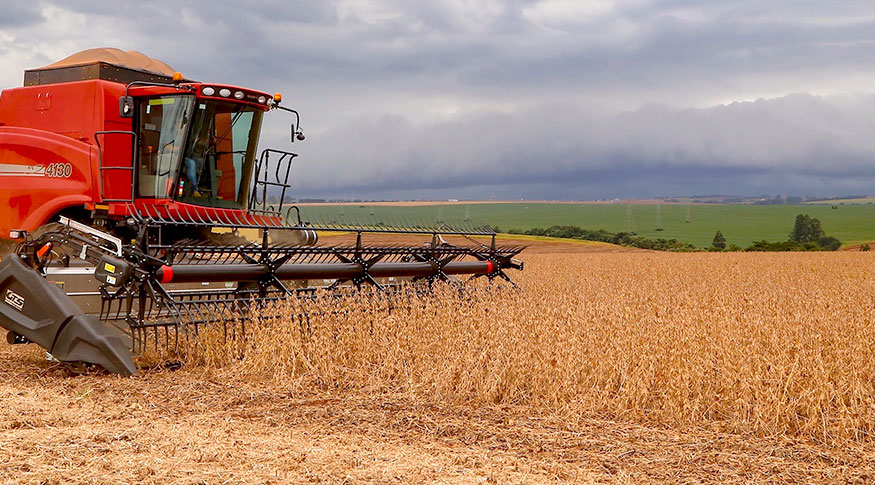Agricultural production
Still under the effect of climate problems, February estimate points out harvest of 300.7 million tonnes for 2024
March 12, 2024 09h00 AM | Last Updated: March 13, 2024 02h37 PM

Released today (12) by the IBGE, the Systematic Survey of Agricultural Production reveals that the national harvest of cereals, legumes and oilseeds should add up to 300.7 million tonnes in 2024. The figure is 4.7% or 14.7 million tonnes lower than that of the harvest obtained in 2023 (315.4 million tonnes). Compared with January, the estimate registered a drop of 0.9%, a reduction of 2.7 million tonnes.
The area to be harvested this year should be of 78.0 million hectares, which means an increase of 0.2% (more 160.5 thousand hectares) in relation to the area harvested in 2023. Compared with the previous month, the area to be harvested increased 383.1 thousand hectares (0.5%).
“In the beginning of 2024, we continue to observe the effects of the climate events that happened last year, like the excess of rainfall in the South Region and the lack of rainfall in the Central-West and North. As the output volume of soybeans is very significant in Brazil, the reduction of 0.8% in the monthly change exerted a big impact on the overall result, as well as the drop in the production estimates of wheat and corn,” highlights Carlos Barradas, manager of the LSPA.
The major negative highlights of the 2024 harvest in February are the production estimates of wheat, corn and soybeans. Corn, soybeans and rice represent 92.0% of the estimated output and account for 86.9% of the area harvested. Compared with 2023, the estimated production of upland cottonseed (5.6%), rice (1.3%), beans (8.1%) and wheat (24.2%) increased. On the other hand, soybeans (-1.8%), sorghum (-14.0%) and corn (-10.8%, being -9.6% in corn - 1st crop and -11.2% in corn - 2nd crop) retreated.
Also compared with 2023, concerning the area to be harvested, it grew 8.6% in upland cottonseed, 4.4% in paddy rice, 5.5%in beans, 0.3% in wheat and 2.1% in soybeans. The areas of corn (-4.7%, being -7.7% in corn - 1st crop and -3.8%in corn - 2nd crop) and sorghum (-5.5%) dropped. According to Carlos Barradas, the increase in the estimate of the area to be harvested, coupled with the reduction in the output, points out a drop in the productivity. “Despite the expansion in the planted area, the productivity is dropping due to the climate problems,” says him.
The estimate in the production of cereals, legumes and oilseeds in February showed a positive annual change for the South (10.3%) and North (2.1%) regions. In the Central-West (-12.1%), Southeast (-8.7%) and Northeast (-4.3%), the index was negative. Concerning the monthly change, the North (1.7%) and Northeast (1.6%) increased. Southeast (-3.2%), South (-2.0%) and Central-West (-0.5%) reduced.
In relation to January, the major increases in the output estimates came from beans - 2nd crop (6.2% or 84 759 t), coffea canephora (1.4% or 15 077 t), beans - 1st crop (1.4% or 13 855 t), beans - 3rd crop (0.8% or 5 485 t), cocoa (0.7% or 1 990 t) and tomatoes (0.6% or 26 632 t).
Conversely, the output estimates for barley (-14.9% or -72 354 t), wheat (-6.6% or -682 744 t), oat (-6.2% or -75 958 t), corn - 1st crop (-3.0% or -782 970 t), potatoes - 1st crop (-2.0% or -33 622 t), grapes (-1.2% or -20 117 t), tobacco (-0.9% or -5 783 t), soybeans (-0.8% or -1 161 714 t), potatoes - 2nd crop (-0.7% or -8 964 t) and corn - 2nd crop (-0.1% or -53 547 t) declined.
“The production of beans and rice should be highlighted as well. Both of them are addressing the demand of the domestic market, avoiding their importation, which consequently helps to fight against inflation in Brazil,” adds Barradas. Considering the three crops, the production of beans should hit 3.2 million tonnes in 2024, a rise of 3.4% over January and of 8.1% over 2023.
With a share of 27.9%, Mato Grosso leads national output of grains
Mato Grosso leads the national production of grains with a share of 27.9%, followed by Paraná (13.5%), Rio Grande do Sul (13.4%), Goiás (10.1%), Mato Grosso do Sul (8.9%) and Minas Gerais (5.7%). These states together accounted for 79.5% of the national estimate. As for the participation of the Brazilian Major Regions, the distribution was as follows: Central-West (47.1%), South (29.3%), Southeast (9.3%), Northeast (8.6%) and North (5.7%).
The major positive changes in the production estimate, in relation to the previous month, came from Rondônia (338 468 t), Bahia (276 958 t), Maranhão (137 271 t), Acre (14 671 t) and Ceará (924 t). The major negative changes occurred in Paraná (-1 623 300 t), Minas Gerais (-917 544 t), Goiás (-705 744 t), Rio Grande do Sul (-180 521 t), Pará (-62 287 t), Amapá (-68 t), Espírito Santo (-12 t) and Rio de Janeiro (-11 t).
About the LSPA
Launched in November 1972 aiming at addressing the demand of users for monthly short-term statistical information, the LSPA provides estimates of planted area, harvested area, amount produced and average yield of products selected based on criteria of economic and social importance for Brazil. It not only follows up each crop investigated in the calendar year of reference, from the intention to plant up to the end of the harvest, yet also the forecast of the harvest in the coming year, for which the months of October, November and December are surveyed. Please access the data on Sidra. The next release of the LSPA will be on April 11.



















